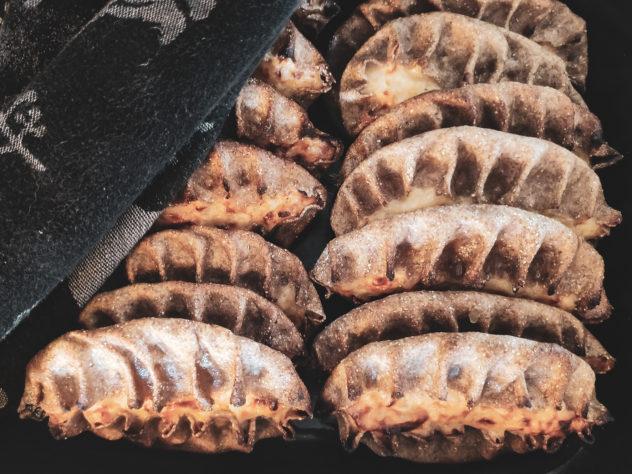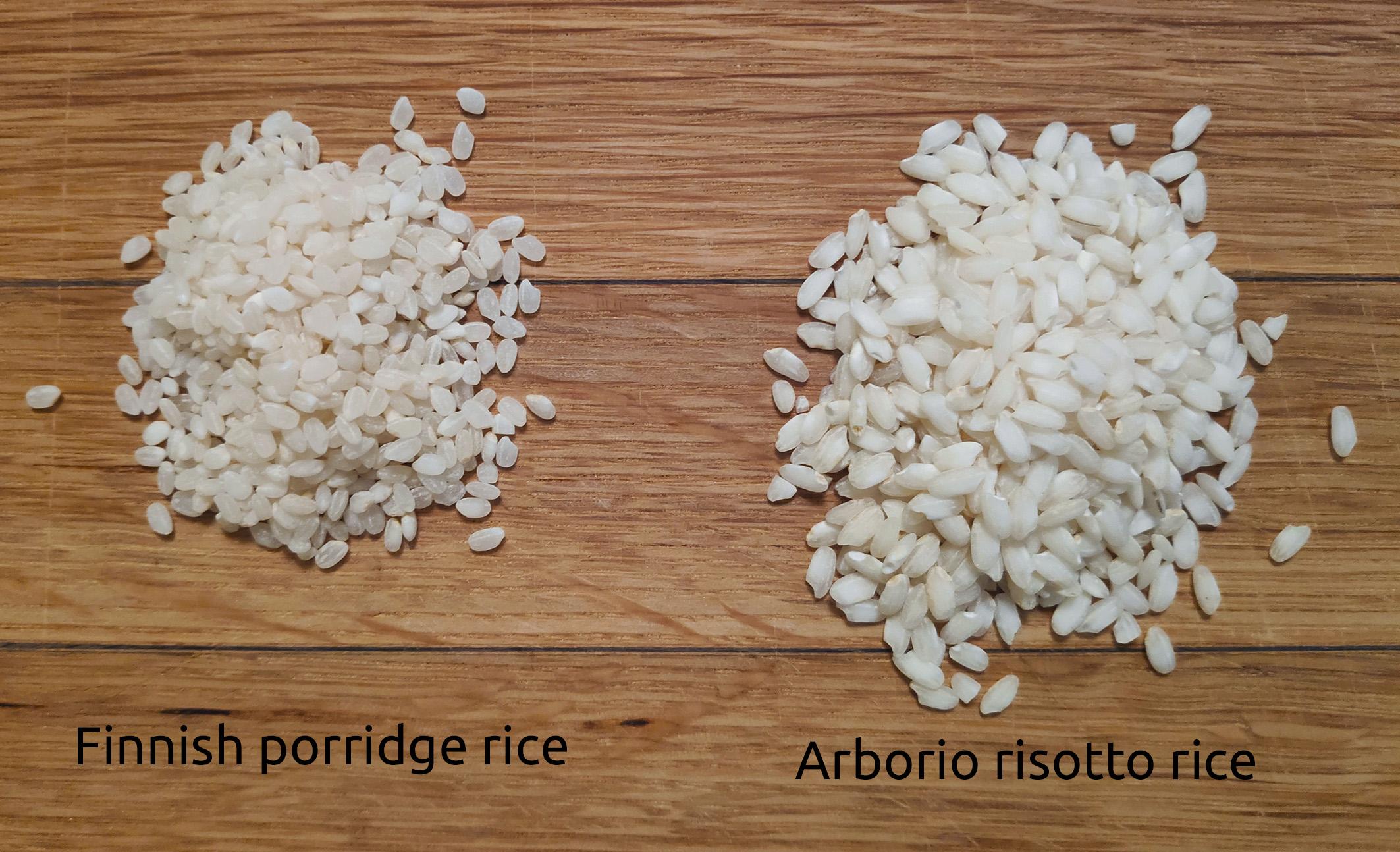I made Asian dumplings for dinner yesterday. Making the little pleats on the dumplings reminded me of a childhood moment with my grandmother. In my memory, she was teaching me how to make Karelian pies (Karjalanpiirakka in Finnish), a traditional dish from the Karelia province where she had her childhood home. She had one pie in front of her, and I had one. We were standing side by side in the kitchen and she was showing me how to carefully make the little pleats on the sides of the pie. This memory made me want to prepare these pies today.
My grandmother was born in Karelia, a former province of Finland. During the Winter War (WWII) the Soviet Union attacked Finland and her family had to evacuate from the lost territory. Before the war, Karelian pies (among other local dishes like the Karelian stew) were only known locally. After the war, the displaced Karelian residents introduced these pies to the rest of the country and they started to become popular. Today, these pies are considered to be such an essential part of our culture that they have gotten the European Traditional Speciality Guaranteed -protection status.
Traditionally, these simple pies were filled with barley or potato porridge. Rice porridge became the most popular filling when rice started being readily available. The main ingredient of the wrapping is rye, which gives these pies a special savory flavor. Wheat is added into the dough to give it elasticity.
Some special tools are traditionally used in the baking process. A special Finnish pie rolling pin is called Pulikka. My grandmother used a dried rabbit’s foot instead of a brush to wipe off the extra rye flour off the wrappers. I used the same foot as a kid and I think that it works better than a normal brush.
There are many ways of shaping the pies. Some people like them rounder in shape and others like them oval. There are also varying opinions on how many pleats each side should have. My grandmother would probably not have fully approved of these Karelian pies that I made as the pleats are quite large. If they were smaller and closer to each other, they wouldn’t burn as easily in the oven.



I will definitely have to try this dish, it looks great! I grew up in a fairly heavily Finnish area of the U.S., but didn’t experience too many Finnish dishes or traditions. It’s really cool that there are such regional dishes! I will have to keep reading your archived recipes as well. My ancestors came from around Kuortane, which I understand is in South Ostrobothnia. Maybe you already have and I just haven’t read them yet, but could you do some dishes from other regions as well?
Hi Jake,
It’s so nice to hear that you’re interested in your Finnish roots and the Finnish culture. I will definitely be sharing more traditional dishes and Finnish traditions on the blog. 🙂 My grandmother from my mother’s side is from Central Ostrobothnia. I interviewed her today about the dishes of that region. I also found a local food study about traditional Finnish dishes, and Pea Soup was named as Kuortane’s local dish. I make my own Finnish pea soup from scratch, so I could write down the recipe and share it here one of these days. It has actually been a wonderful dish during the time of social distancing, as dry peas store in the closet for a long time!
I will be making karjalanpirrikka today. I have been looking for a new recipe to try. I’ve used a few different ones over the years. I came across your blog and your recipe looks pretty authentic! Excited to try it!
Hi,
Great to hear that you’re going to try my grandmother’s Karelian pie recipe. Let me know if you have any questions about the recipe or the baking process! If you are interested in other traditional Finnish dishes as well, you can find my other posts here: https://windfromthenorth.com/tag/traditional-dishes/
Happy baking!
What a beautiful pie, do you mind kindly give me the Finnish name of the wheat flour And the rice‘S name in Finnish please? Love to try your recipes . Thank you. 😉
Since I am newly moved to Finland . And still confused about which flour is which in Finnish supermarket. If you could kindly give me these flour ingredients names so I could buy them in Finland . Thanks very much again for your recipes. Can’t wait to try making it
Hi Ty,
Visiting a Finnish flour aisle at the supermarket can be somewhat confusing, because we don’t have a flour standard that would directly correspond with the German or Italian one for example. Here are a couple of flour tips that should help you with shopping. 🙂
The wheat flour that I use in this recipe is called “erikoisvehnäjauho” (which literally means special wheat flour). You can also use “puolikarkea vehnäjauho” (half coarse wheat flour, the Finnish equivalent to all-purpose flour). The difference between these two flours is that puolikarkea vehnäjauho is ground a bit finer than erikoisvehnäjauho. If you see “täysjyvävehnäjauho” in the shop, that’s full grain wheat flour.
Normally you only find one type of rye flour in the stores. That’s “ruisjauho”.
The Finnish porridge rice is called “puuroriisi”. Porridge rice has replaced pearl barley in many traditional Finnish dishes, so you can make some Finnish rice porridge or a traditional cabbage casserole with the leftover rice. 🙂
Hi Veera,
thanks soooo much for your kind and fast reply, your explanation is so much appreciated. Honestly….the flour section in Finnish supermarket is so confusing for a foreigner…sigh. I am so glad that I discovered your website. And thanks so much for your help.
May I ask one more question please?
What would be the flour’s name which equivalent to CAKE FLOUR, since I am also trying to bake cake and muffin as well.
And what could be equivalent to BREAD FLOUR pls?
Since my bread tends to be sticky when i try to use Finnish flour for baking bread.
By the way, reality appreciate your recipes and all your photos are beautiful. Thx again.
Thank you so much!! 🙂
We don’t have bread flour and cake flour as such, but you can use erikoisvehnäjauho and puolikarkea vehnäjauho instead.
I’d recommend erikoisvehnäjauho for recipes in which you want use baking soda or baking powder (for example cakes, pies, cookies, pastries). You can use this flour also for recipes without any leavening agent (like buttery pie crusts).
Puolikarkea vehnäjauho is great for baking bread. I’d use it in recipes in which you need yeast or a sourdough (for example sweet buns or beer malt bread.
Hi Veera,
Millions thanks…your information is very helpful. your blog is a star blog for finnish food^^
and i am already write down all your helpful info as a start for my explore into Finnish food. thxxxxxxxxx
Hi Veera,
And I shall definitely look into the rest of your blog too to try other recipe like your cabbage casserole. i have brought some liver and carrot casserole in K supermarket in Xmas. i hope you will also teach us how to make them too one day. And i really hope you can teach us more about different Finnish bread too. Thanks again for your kind reply. ^^
That’s great to hear! My favorite Christmas casserole is definitely the yellow turnip casserole and it’s soo good when it’s fresh and home-made. I really should write down the recipe and share it some time. 🙂
Thank you , can’t wait for more of your recipes….^^
This recipe gave me the best results I’ve ever had! Thank you!
Hi Maija,
That’s great to hear! 🙂
Hi, can I use risotto rice for the filling?? Many thanks
Martin
Hi Martin,
Different risotto rices and the Finnish porridge rice are all short-grained rice species, but in my experience most risotto rices tend to stay a bit chewy even after cooking. I think that the short-grained rice closest to the Finnish porridge rice would sushi rice. I’ve never tried using risotto rice for the rice porridge, but I assume that it might work with a longer cooking time. If you decide to try making the porridge with risotto rice, I would love to hear how it turned out!
I took a picture of the Arborio rice that I normally use for making risotto and the Finnish porridge rice. As you can see, the grain size of the Finnish rice is quite a bit smaller.
Hi! What a wonderful post. I was just wondering how these are best stored? How long can they be stored? And can they be frozen?
Thank you 🙂
Hi Kate,
I like to store my Karelian pies in a paper bag, and they don’t need refrigerating. You should eat them 1-3 days because otherwise they’ll start drying out.
Freezing Karelian pies actually works great! You’ll get the best results when you freeze the unbaked pasties (on a baking tray so that they don’t stick to one another when they’re still fresh), and just bake them whenever you’d like some fresh pasties. ☺️